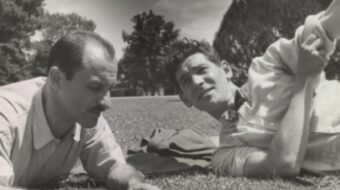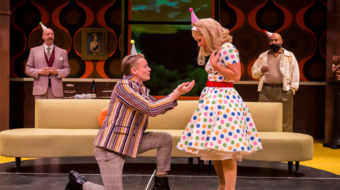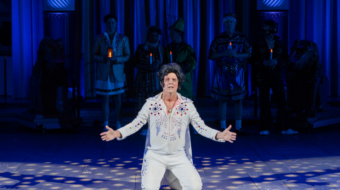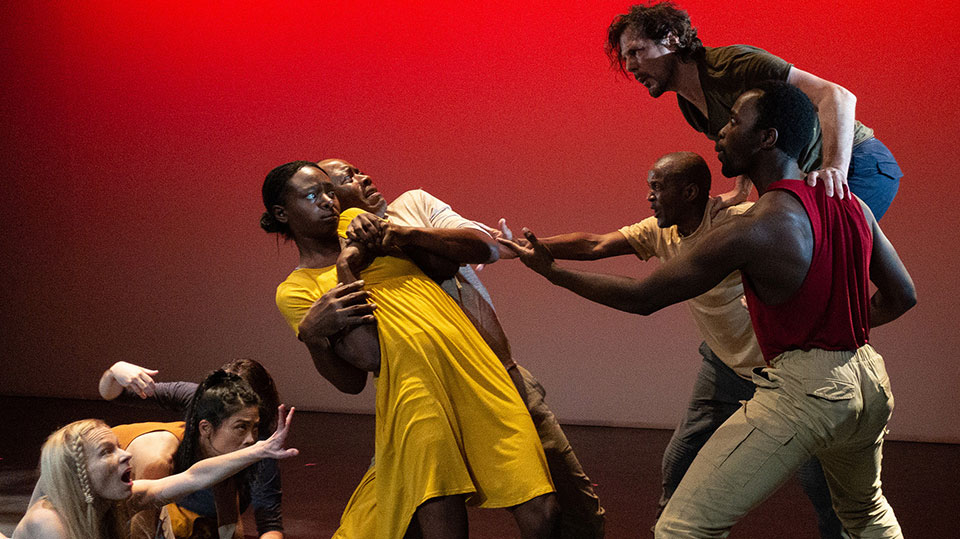
LOS ANGELES — On October 26 I saw Tom Stoppard interviewed on PBS’ Amanpour & Company, and the British playwright stated that “theater is a storytelling art form.” While I hold the bard who wrote 1966’s Rosencrantz and Guildenstern Are Dead in high esteem, there are some intrepid souls in the realm of the stage who’d beg to differ with Stoppard’s definition/description of theater.
Among these iconoclasts are the late playwright Jean-Claude van Itallie, who collaborated with Joseph Chaikin and the experimental, New York-based Open Theatre circa 1969 to co-create The Serpent, which another pathfinder of the boards, Ron Sossi, directed 51 years ago as the West Coast premiere of this Obie Award-winning play. Conventionally speaking, narrative theater is usually a story and character-driven medium generally told in a linear way, relying heavily on dialogue and plot. However, there are other ways for plays to be conceived, presented, and performed, methods which were more commonplace during the heady days of the 1960s-’70s.
According to press notes, Chaikin—who founded the Open Theatre as a split-off from the legendary Living Theatre in 1963—asserted: “Off-off Broadway’s impulse was a terrific dissatisfaction with what is possible on Broadway…. Off-off Broadway is really an attack on the fourth wall. It wants to destroy the fourth-wall business.” The “fourth wall,” of course, is the imaginary invisible wall that separates the audience from the actors on stage, who are often glimpsed through a proscenium arch, as if viewers are watching a slice of life unfold on the boards.
Notice that I don’t refer to narrative or fourth wall as being “traditional.” Because The Serpent, as performed by the Open Theatre and currently by the Odyssey Theatre, harkens back to primal ceremonies, rituals, and other “primitive” traditions, relying on other means besides dialogue and plot to convey its meaning. Because in addition to merely telling stories, live theater can also express emotions, ideas, and more, as The Serpent does in unconventional ways.
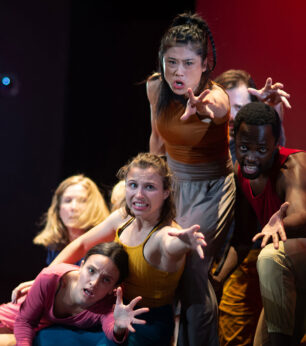
Instead of telling a single tale, in The Serpent the dozen multi-culti, mostly young members of the Odyssey Theatre Ensemble stage a series of vignettes with an improvisational vibe. As the title suggests, what’s probably the play’s dominant theme adapts parts of the Book of Genesis, with Adam (Terry Woodberry) and Eve (Atiya Walcott) in the Garden of Eden. The saga of Cain (Caucasian Joseph Gilbert) and Abel (Kenyan Raymond Watanga) unfolds, and considering the brutality perpetrated by a white character against a Black victim, perhaps Cain belonged to a primeval “Adam-12” unit?
In this fragmented, avant-garde production, another stirring vignette revisits the JFK assassination, with Gilbert as Pres. Kennedy and Avery Dresel-Kurtz as Jackie. The highly stylized reenactment includes a larger-than-life projection of the most significant home movie in cinematic history, the Zapruder film—the 8mm strip of celluloid that captured the liquidation of the president—on the rear wall of the Odyssey Theatre. I’ve never seen the Zapruder film blown up so large and so up-close and personal (with the possible exception of watching Oliver Stone’s JFK on the big screen in a movie theater). Needless to say, watching those murderous moments remains shocking to the senses, especially when counterpointed to the Ensemble’s onstage actions. (Video design is by Diana Cignoni—and, to be fair, Abraham Zapruder.)
In another sketch, the troupe carries out an autopsy atop a big black box, set designer Stephanie Kerley Schwartz’s sole concession to sets and props on an otherwise bare stage. If all this sounds grim, there is also a sort of group orgy with all of the six couples rapturously, playfully making love onstage. (All of the pairings are male-female, despite the fact that van Itallie himself was gay; the actors remain, alas, clothed; and the coupling stays monogamous. Perhaps not so edgy after all—where is Julian Beck when you need him? LOL.)
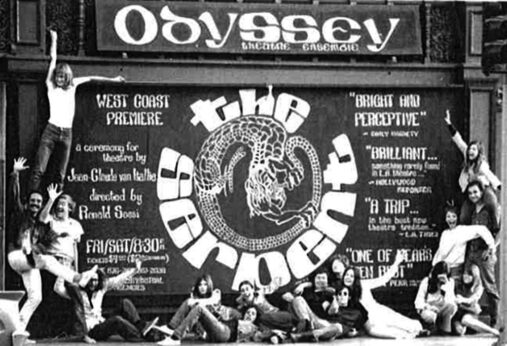
Although the show runs not much longer than an hour, there is so much going on that it feels, in a good way, like a full evening’s production. The Odyssey ensemble includes Avery Dresel-Kurtz, Joseph Gilbert, Elin Hampton, Tomoko Karina, Kristina Ladegaard, C.J. O’Toole, Ian Stewart Riley, Carla Valentine, Atiya Walcott, Raymond Watanga, Terry Woodberry, and Peyton Young. The choreographer is Kate Coleman. The Serpent is directed by the venerable Ron Sossi, founder and artistic director of the Odyssey Theatre. In 1970, The Serpent was the second play presented by the then-brand-new Odyssey Theatre and this revival is part of the Odyssey’s 50th Anniversary “Circa ’69” season, a “retrospective of seminal theater works that inspired the Odyssey at the time of its inception.” The recent pandemic sidelined this retrospective that is finally, happily, returning to the live stage.
Sossi admirably helms The Serpent’s ensemble, which at times meshes into a single living organism. Van Itallie’s still daring work reminds audiences that there are other modes of expression possible in the theater, besides merely the spoken word, plot, and other conventional means and devices. When I grew up in New York City I remember hearing about the Open Theatre but was too young to partake of its performances. It’s been almost half a century but it has been worth the wait. Although I can’t say I understood everything I saw, I can honestly say that I enjoyed making my odyssey across L.A. to the Odyssey, slithering down to see The Serpent. This is a highly recommended theatrical experience for more adventurous theatergoers who enjoy taking a walk on the wild side when they venture forth to a live stage.
The Serpent runs Fri. and Sat. at 8:00 p.m. and Sun. at 2:00 p.m. through Dec. 12 at The Odyssey Theatre, 2055 S. Sepulveda Blvd., Los Angeles 90025. For info: (310)477-2055, ext. 2, or go to the company website. Ticket buyers are, as of this writing, required to provide proof of vaccination and wear masks (even though it’s not commedia dell’arte).



